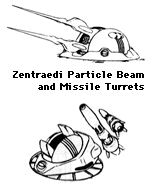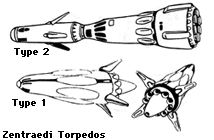

Designation:Nupetiet Vergnitzs-class Fleet Command Ship |
|
||||

|
|||||
Note: While Zentraedi ships have been assigned Terran naval/space type designators, it must be stressed that their size and armaments placed them in a class of their own, matched only by contemporary Tirolian and modern Terran construction of like designations. As such, their designations must be viewed as indicators of intent and use rather than absolute strength. In addition, the proper translation of the Zentraedi vessel designations into English was never completely agreed upon; for instance, some texts call the Nupetiet Vergnitzs-class fleet command ship a 'flagship' or 'lead battlecruiser'. Some other sources drop the "g" in Vergnitzs; this is because of an early lack of understanding of the palatalized "n", called "gnoumon". No seperate character exists for this in the Zentraedi alphabet, and it is denoted by a diacritical - a dot above the letter "n".
These ships were built at numerous locations throughout the Robotech Mercantile Empire from 1498 through 1840 and at the Robotech Factory Satellite from 1830 through 2009. There have been three different versions of the Nupetiet Vergnitzs-class. The first version was built in small numbers only (43), and was followed in 1501 by the second version. The Ci'Vonian crisis of 1512 led to a redesign which became the third version. This version, while receiving numerous upgrades to its subsystems over the years, remained in production for 497 years. It was proven impossible to refit the second version with the improvements of the third version. The total number of Nupetiet Vergnitzs-class fleet command ships constructed is 41,528.
Of the first two versions (2,645 built total), 56 were destroyed prior to the Ci'Vonian disaster. During the disaster, 896 Nupetiet Vergnitzs-class vessels defected to the Ci'Vonian side. In the wars and skirmishes that followed, no less than 815 of the renegade ships and 1,103 of the 1,493 loyal vessels were reported as destroyed or suspected to have received action damage that led to their constructional total loss. The remaining 390 Tirolian vessels were all decommissioned as the first Nupetiet Vergnitzs-class vessels of the third version entered service. Of this final version, 38,883 units were completed. Of these, 2,743 were destroyed prior to 2010. The Imperial Class fleet contained 15,827 Nupetiet Vergnitzs-class vessels, all sharing in the "infection" of that fleet. Of the remaining Tirolian controlled ships approximately 19,400 were part of the Grand Fleet. After the Zentraedi Holocaust, approximately 900 Nupetiet Vergnitzs-class vessels remained in the Tirolian fleets, and 1 in the RDF Zentraedi fleet, although another was captured with the Robotech Factory Satellite in 2014. However, most of the Zentraedi vessels suffered from protoculture depletion and the RDF decommissioned both their Flagships within the next year. The remainder were failed, decommissioned due to protoculture depletion or destroyed around 2020.
(Note: this applies only to the final systems of the third version. The differences between the second and third versions are detailed in the text).


As the command ships for fleets, often numbering in the thousands of ships, the Nupetiet Vergnitzs-class was the most prestigious in the Zentraedi navy. Duty on such a ship as a staff officer was often the prelude to an assignment as commanding officer of a smaller flotilla. The Nupetiet Vergnitzs ships had the firepower and troop capacity to defend their standing as well, making the class the most heavily armed of all Zentraedi vessels save monitors, and second only to a dedicated Quiltra Queleual only in troop carrying capacity. So voluminous was the class that they often doubled as tenders for the smaller vessels.
The Nupetiet Vergnitzs-class can best be described as a lumpy, vaguely rectangular box 4 km long, with a slightly greater height than width. In addition, a large hangar extending below the hull proper to the rear gave the class an almost pregnant appearance. The front end was marked by the four angular blisters which mounted the phased array transmitters of the so-called manual override beam system, which was capable of overriding the navigational systems of a large number of mecha remotely. The antenna's were mounted on the covers of the forward main particle beam cannons. In combat, these covers opened backwards to unmask the heavy cannons underneath. Fourteen more heavy cannons were mounted, eight under and two on top of the forward hull, and four more divided over the aft dorsal and ventral. As remarked above, a large hangar assemblage was further aft on the ventral. The rear of the ship mounted the eight main reaction engines.
The armament is, like most Zentraedi designs, concentrated forward. The heavy cannons are either mounted in the nose or capable of firing in most forward angles. In addition, the yield of the heavy particle weapons is second only to the new generation weapons mounted on the Macross class. Over half of the medium cannon armament is located forward as well, mostly of the forward nose surface and the forward flanks and chin. This still leaves enough batteries for a more than adequate coverage of the other firing arcs. The heavy torpedoes are mounted in the groove between the bottom hull and the upper armour sections, in the forward part of the ship. Although these launchers are the standard Zentraedi type also mounted on their other ships, the Nupetiet Vergnitzs mounts more of these tubes than any other design. Finally, there is an extensive defensive missile system installed on all arcs.
Internally, there are 11 deck levels. Mecha bays are mounted on all sides, as well as forward and on the dorsal and ventral. However, few of these hangars are suited for the larger auxiliaries as well. One of these is of course the large ventral hangar, and another auxiliary ship bay is mounted on the dorsal, aft of the upper heavy particle cannons. Two side bays can also contain one Quel Quallie or several smaller vessels. The command spaces and several cargo and holding bays are sited in the nose of the ship. The central section is mostly dedicated to fuel, mecha bays and attitude thrusters. Farther aft are the lower hangar and the reaction engines. Troop and crew quarters are mostly forward or aft of the center section.
The older versions of the Nupetiet Vergnitzs have not been in service with the Tirolian Empire for almost four centuries. They were generally identical to the well known 3rd version, their most obvious difference being a smaller lower hangar, an enlarged upper hangar, no heavy cannons on the dorsal and no manual override system in the nose. Theoretically, a few of these vessels may still be operational with the Disciples of Zor, but they are fast nearing the end of their designed hull lifespan.
In order to command their ever growing fleets, the Tirolian Mercantile Empire designed the Nupetiet Vergnitzs-class fleet command ship for its highest Zentraedi commanders. The fleet command ship was equipped with quarters for the staff needed to control task forces of several thousands of ships. To protect these staffs, and to project power in their own right, the Nupetiet Vergnitzs was the most powerfully armed Zentraedi ship save a monitor.
The Ci'Vonian crisis was a disaster for this class as much as it was for the rest of the Zentraedi and the Empire. Almost one out of three fleet command ships had fallen prey to the mass defections that formed the most dangerous part of the crisis, and the other ships were immediately at the forefront on the ensuing war. Few of the class survived the following two years of furious fighting, as they were natural targets for all enemy ships. As part of the reforms triggered by the crisis, the Nupetiet Vergnitzs-design was reviewed, and soon a third version came into use. This subclass soon replaced the older versions, which were decommissioned and scrapped. The alterations included an upgrading of the armament, with 40 more medium cannons mounted, and an additional two heavy cannons were installed on the dorsal. This prompted a relocation of much of the dorsal hangar space to the ventral, and gave the class the odd looking 'pregnant' appearance. Most important refit, however, was the fitting of the manual override beam system to the front of the vessel. with this device it was hoped that a closer control could be enforced, and the chance of further defections reduced considerably.
Over the next four centuries, the Nupetiet Vergnitzs fulfilled their roles as fleet command ships with impressive reliability and acumen. The sight of such a vessel often caused a greater apprehension under its opponents than a larger number of ships would, as a fleet command ship usually meant a large number of ships were nearby, or it served as a sign that major attention was now being directed towards the theatre.
Typically, a Nupetiet Vergnitzs controlled two hundred ships or more. Other fleets could be assigned as well, so the number of ships assigned could climb far higher than the more common number. For example, the Imperial Class fleet, almost a million ships, were all commanded from a Nupetiet Vergnitzs-class vessel. In addition to their combat and command taskings, the class also often served as a tender for the smaller vessels such as the Tou Redir class, which could not carry that many supplies, and often transferred some of the command ships' stores to replenish their won. Another vital function was battlefield reconnaissance and air cover. Relatively, the Nupetiet Vergnitzs carried a large fleet of scout auxiliaries and Gnerl fighters. These were considered to be command assets, to be deployed as battlegroup reserve. The troops carried on board were also generally experienced units, with a disproportionate amount of cavalry troops, which made them faster and harder-hitting than more common troop allotments, although they could sustain this for less time before they required relief.
While the Zentraedi Holocaust virtually wiped out the Zentraedi fleets, losses among the Nupetiet Vergnitzs ships were relatively the highest of any class, for the RDF alliance deliberately gave them a higher priority in their targeting systems, and the Grand Fleet lost most of its coordination early on and the individual ships tended to concentrate on the later ships in their range. Very few ships survived, and by 2020 these too were all powerless, decommissioned or destroyed.
Return to Zentraedi Index
Go to Robotech Reference Guide Home Page.
Robotech (R) is the property of Harmony Gold. This document is in no way intended to infringe upon their rights.
Content by Pieter Thomassen and Peter Walker